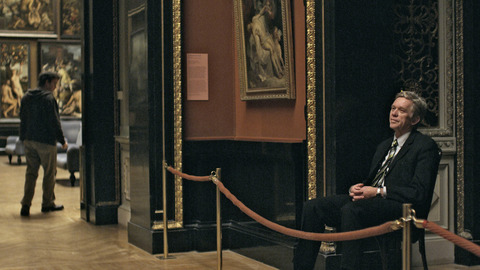Museum Hours
Jem Cohen’s “Museum Hours” is a contemplative, leisurely look at the world of art as a parallel to ours. A loose narrative pulls together the director’s musings on the correspondence between the two. The story, such as it is, introduces us to a Canadian woman (singer Mary Margaret O’Hara) who travels to Vienna to visit a cousin she hasn’t seen in years and who has fallen in a deep coma with little chance of recovery. For someone with scant financial means and who doesn’t know anyone in the Austrian capital, spending time at the Kunsthistorisches Museum helps while away the hours between visits at the hospital. There she finds an unlikely connection with another lonely soul, Johann (Bobby Sommer), a guard at the museum, who helps her find her way in the city, talks to doctors at the hospital as she speaks no German and, on his days off, takes her round a Vienna of immigrant cafes, underwater grottos, and bland neighborhoods, far from the tourist-heavy tracks. A friendship—or a kinship—of sorts starts between them, with the unspoken awareness of the tenuous and temporary nature of the bond.
Although filled with treasures—works by Rembrandt, Bruegel and others—the museum, not one where crowds have to stretch their necks in order to see a famous painting, is quiet and stately. Through Johann, a rock musician in his youth and a museum guard for six years, the director contemplates the nature of art and its ramifications on viewers. Regarding Bruegel particularly, he gives a voice to a docent doing a guided tour. Enraptured with the artist, she defines the sixteenth-century master’s unique place in the pantheon of major artists through his vision of the peasantry he depicts.
But more than the slight narrative, more than the reverence of time spent in these hushed halls, Jem Cohen’s camera takes us on a different track altogether which is the principle of seeing. How much do we actually see of the details in art as well as in the quotidian surrounding us? Sure, our eyes catch things, sweep over familiar sights without paying attention, are sometimes snagged by an unexpected object, a particular color combination, the unconventional form of a building, but what do we see? As much as the paintings and the ancient sculptures in the museum, we are shown the city outside in its barebones reality, a green glove or an empty beer can half-buried in the snow, the miserable debris of a flea market. Then there are the close-ups of faces on the metro, on the street, at a balcony, a youngster in a red hoodie, the tired expression of a homeless man—perhaps a reminder of the innumerable self-portraits of Rembrandt fascinated with the process of his own creeping age—an old woman climbing a steep lane and disappearing round the corner while red car tail lights bring to life the road below the overpass.
Cinema-wise, we may be too exposed to over-constructed stories zipping along on brutally loud sound tracks to be satisfied by “Museum Hours.” Meditation wise, on the other hand, it is fulfilling as few films in recent memory.
news via inbox
Nulla turp dis cursus. Integer liberos euismod pretium faucibua


